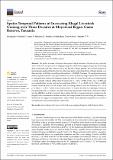Spatio-Temporal Patterns of Increasing Illegal Livestock Grazing over Three Decades at Moyowosi Kigosi Game Reserve, Tanzania

View/
Date
2021-12-02Author
Musika, Nyangabo
Wakibara, James
Ndakidemi, Patrick
Treydte, Anna
Metadata
Show full item recordAbstract
The global increase of livestock has caused illegal intrusion of livestock into protected areas. Until now, hotspot areas of illegal grazing have rarely been mapped, long-term monitoring data are missing, and little is known about the drivers of illegal grazing. We localized hotspots of illegal grazing and identified factors that influenced spatio-temporal patterns of illegal grazing over three decades in the Moyowosi Kigosi Game Reserve (MKGR), Tanzania. We used questionnaires with local pastoralists (N = 159), georeferenced aerial survey data and ranger reports from 1990–2019 to understand the reasons for illegal grazing in the area. We found that hotspots of illegal grazing occurred initially within 0–20 km of the boundary (H (3) = 137, p < 0.001; (H (3) = 32, p < 0.001) and encroached further into the protected area with time (H (3) = 11.3, p = 0.010); (H (2) = 59.0, p < 0.001). Further, livestock herd sizes decreased with increasing distance from the boundary (R = −0.20, p = 0.020; R = −0.40, p = 0.010). Most interviewees (81%) claimed that they face challenges of reduced foraging land in the wet season, caused by increasing land used for cultivation, which drives them into the MKGR to feed their livestock. We conclude that there is spatio-temporal consistency in the illegal livestock intrusion over three decades, and hotspot areas are located along the boundary of the MKGR. We suggest focusing patrols at these hotspot areas, especially during the wet season, to use limited law enforcement resources effectively.
